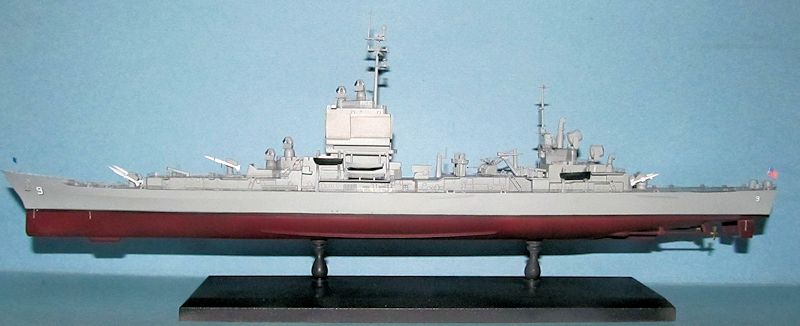
Dragon 1/700 USS Long Beach (CGN-9)
| KIT #: | 7091 |
| PRICE: | $42.39 SRP |
| DECALS: | One option |
| REVIEWER: | Dan Lee |
| NOTES: |
GMM 1/700 Modern US Navy PE Set used |

| HISTORY |
USS Long Beach was the first and only member of its class because it was
the test ship for the AN/SPS-32 and 33 phased array radars which were the
ancestors of the SPY-1 radars used currently by the Aegis class CGs and Arleigh
Burke DDGs.
She was also unique as she was the last cruiser in the US Navy
based on a cruiser hull as all subsequent cruisers were built on
frigate/destroyer leader or extended Spruance destroyer hulls.
The Long Beach was launched July 14, 1959 as the first nuclear powered
combatant and supposed to have an all missile armament including Regulus and
Polaris missiles but later added two 5 inch guns at the request/demand of
President John F. Kennedy.
Designed to escort nuclear powered ai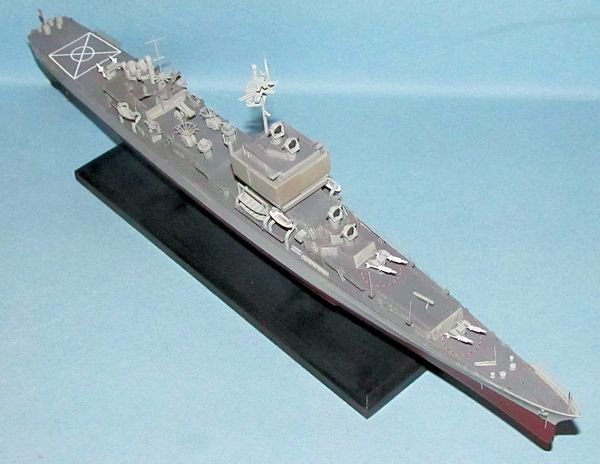 rcraft
carriers such as the (soon to be decommissioned) USS Enterprise, the Long Beach
carried two Terrier and one Talos SAM launchers along with an ASROC launcher,
two triple tube ASW torpedo tubes as well as the two aforementioned 5 inch guns.
Later in the Cold War, Standard SAMs replaced the
Terriers, the Talos launcher was deleted and was replaced with Harpoon and
Tomahawk ASMs instead.
rcraft
carriers such as the (soon to be decommissioned) USS Enterprise, the Long Beach
carried two Terrier and one Talos SAM launchers along with an ASROC launcher,
two triple tube ASW torpedo tubes as well as the two aforementioned 5 inch guns.
Later in the Cold War, Standard SAMs replaced the
Terriers, the Talos launcher was deleted and was replaced with Harpoon and
Tomahawk ASMs instead.
She was also one of the first warships to make extensive use of aluminum
for its superstructure which turned out to be a major mistake as discovered
during the 1975 John F Kennedy/Belknap collision and the Falklands war where
aluminum superstructures proved to be a major fire hazard.
Her callsign was ďAlcoa.Ē
The Long Beach served with the Atlantic Fleet till she was transferred
to PACFLT in 1966 and soon went to Vietnam.
She acted as the ground controller to guide an F-4 to
shoot down an An-2 Colt in 1967 and shot down two Mig-17s with her Talos
missiles during 1968 in the Gulf of Tonkin.
She served with PACFLT for the rest of her active life including
Operation Nimble Archer during 1987.
Thanks to the US having to face the cost of the Cold War
(including the 600 ship Navy), the US Navy decided to deactivate all its nuclear
power cruisers when they needed refueling.
The Long Beach was decommissioned in 1994, had her
reactors and superstructure removed in 1995 and sold for scrap in 2012.
| THE KIT |
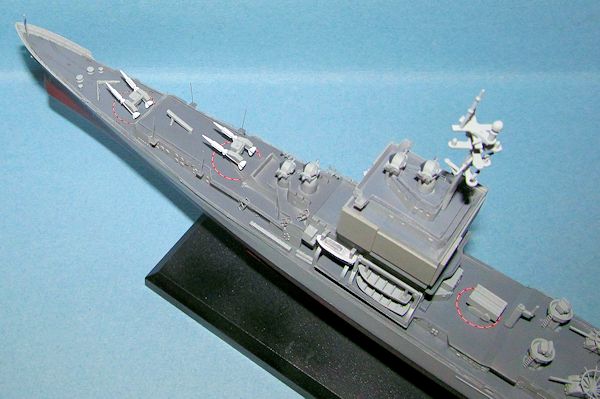 Dragonís
Long Beach contains fittings for the original 1961 configuration without guns
and the 1967 version which does.
The hull is a two piece affair that is split at the
waterline (and comes with a stand) for those who wish to build the full hull or
wish for a waterline version/diorama.
It comes with nine sprues of parts, a small decal sheet
and a PE fret.
Dragonís
Long Beach contains fittings for the original 1961 configuration without guns
and the 1967 version which does.
The hull is a two piece affair that is split at the
waterline (and comes with a stand) for those who wish to build the full hull or
wish for a waterline version/diorama.
It comes with nine sprues of parts, a small decal sheet
and a PE fret.
The detail on these parts is very good and free of flash.
All the parts for the 1961 and 1967 configurations are
provided.
The PE fret contains the stairs and 5 inch gun crown radars
(however, the rings for the crown radars are actually too big), but not for the
railings.
Instructions for this kit are the typical Dragon
instructions which are sometimes vague (hence frustrating) and the paints colors
they use are Gunze but I used Tamiya equivalents instead.
| CONSTRUCTION |
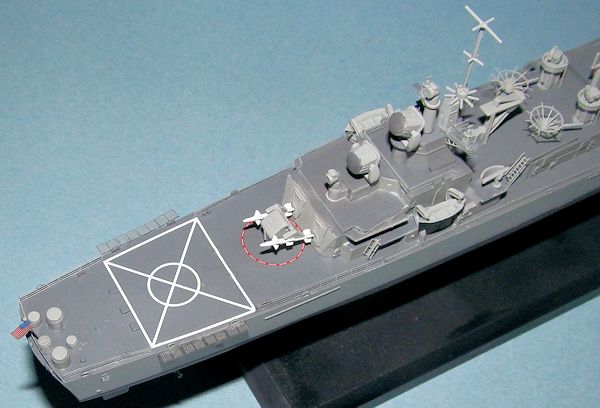 It
all began with the hull.
I opted to build the Long Beach with the full hull and
1967 configuration.
I glued the hull together (the rudders and prop shaft
were glued on) and used a little bit of Vallejo plastic putty at the bow.
It
all began with the hull.
I opted to build the Long Beach with the full hull and
1967 configuration.
I glued the hull together (the rudders and prop shaft
were glued on) and used a little bit of Vallejo plastic putty at the bow.
I built the deck and superstructure layer by layer and
left off any parts that were painted a different color than the hull, but did
not glue it all together till I was done painting.
The deck fittings, antennas and weapons were cleaned up and assembled if
they were to be painted the same color.
The only problem I had was with the gun crown radars as
the ring was too big.
Yes, it was that easy.
| COLORS AND MARKINGS |
This is where things got complicated.
First thing I did was paint the entire hull haze grey
(actually Tamiya XF-80 Royal Grey.)
Next I masked off the top part of the hull and sprayed
the lower hull Tamiya Hull Red.
I took some 4mm wide tape and masked off areas
surrounding the waterline black stripe and painted it.
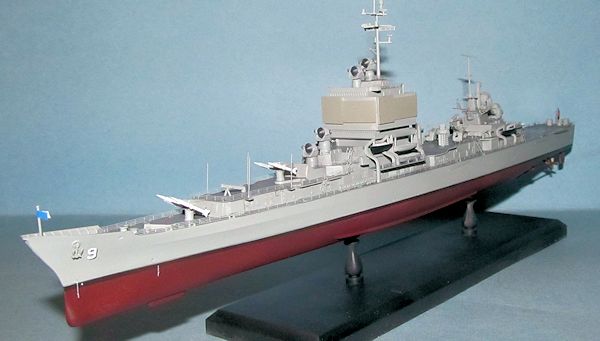 The
vertical surfaces of superstructure parts and guns were painted haze grey as
well as the deck fittings, PE stairs, antennas, missile launchers, etc.
The missiles were painted white.
The
vertical surfaces of superstructure parts and guns were painted haze grey as
well as the deck fittings, PE stairs, antennas, missile launchers, etc.
The missiles were painted white.
When the Haze grey was dry, I masked off everything I could and sprayed
on Tamiya Kure Grey XF-75 which I used for the deck grey while I used Medium
Grey for the Radar Panels that surround the superstructure.
When the modelís hull and superstructure was glued
together and mounted on the stand (which was painted flat black) I sprayed on
several thin coats of Future for the decals.
The props were sprayed Tamiya Gold Leaf.
The Dragon decals went on without much issue.
I didnít even need Microsol or Microset.
| FINAL BITS |
I did this in between painting.
The superstructure parts were added and the various tiny
parts including hand painted life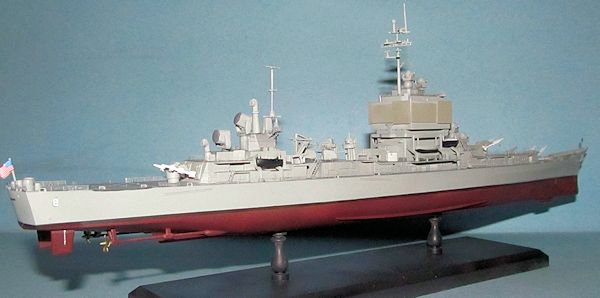 boats
were glued in place.
The SAMs were glued onto the launch rails with CA glue.
boats
were glued in place.
The SAMs were glued onto the launch rails with CA glue.
The kit comes with way too think radio aerials (?)
located next to the 2nd Terrier Launcher so I replaced those with .008 thick
brass wire that was painted haze grey and glued on with CA glue.
I recently purchased a Gold Medal Modelworks PE set for 1/700 USN modern warships which was sprayed Haze Grey. I used this to add railings where ever needed. I didnít add many rails midships because I was kind of lazy so my excuse is that assumed that they would be removed during action stations. I used internet photos to figure out where the rails went and there actually more than I thought there were. The set even had rescue netting which I used around the helo pad.
| CONCLUSIONS |
If you want to build a 1/700 warship then I recommend the Long Beach as a great starter. It is ridiculously easy to put to together and if you plan your painting ahead of time then it is really no trouble at all.
April 2013
If you would like your product reviewed fairly and fairly quickly, please contact the editor or see other details in the Note to Contributors.